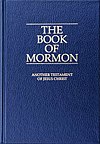
Back Kniha Enos Czech Libro de Enos Esperanto Libro de Enós Spanish Libro de Enos Interlingua Kitab Enos ID Li libre Enos Interlingue Libro di Enos Italian Libro de Enos LFN Livro de Enos Portuguese انوس کی کتاب Urdu
| Books of the Book of Mormon |
|---|
 |
| Small Plates of Nephi |
| Contribution of Mormon |
|
| Additions by Moroni |
|
The Book of Enos (/ˈiːnəs/) is the fourth book in the Book of Mormon and is a portion of the small plates of Nephi.[1] According to the text it was written by Enos, a Nephite prophet.
Identity of Enos According to the Book of Mormon, Jacob had a son named "Enos" (see Jacob 7:27) and because the Book of Enos follows immediately after the Book of Jacob in the manuscripts of the Book of Mormon and all printed editions, the Book of Enos is apparently the book that next followed the Book of Jacob on the small plates of Nephi. (See Jacob 7:27 to Enos 1:1.) However, in the opening verse of the Book of Enos (Enos 1:1), Enos mentions only his "father" and does not expressly affirm that his father was Jacob or that his uncle was Nephi. It is a reasonable assumption that Enos was the son of Jacob (of Jacob 7:27); but that relationship is not established in the text.
Given the issues that have been debated about how it could have been fully 179 years between the time when Lehi (and Nephi) left Jerusalem and when Enos "began to be old" (Enos 1:25) and was "soon" to "go to the place of [his] rest" (Enos 1:27), it is possible either that Jacob and Enos each lived to about 95 years of age (which is possible), with Jacob fathering Enos late in life (which also is possible), or that Jacob had one son named Enos (as stated in Jacob 7:27) and yet that the Enos of the Book of Enos was another Enos altogether, perhaps, for example, a grandson or even great-grandson of Jacob. The identity of Enos of the Book of Enos is not necessarily established as the son of Jacob and grandson of Lehi and Sariah. Clearly, however, Enos's ancestry leads directly to Lehi and Sariah through Jacob.
Summary of the Book of Enos This short book consists of a single chapter, relating Enos' conversion after praying all day and all night, following with his subsequent dialogue with the Lord. It also discusses the redemption of the Nephites and their enemies, the Lamanites, and contains prophecies of future Nephite and Lamanite generations. Additionally, it contains descriptions of the Lamanites. The style of Enos resembles that of Erich Auerbach in his Mimesis and that of Nephi, Enos's ancestor and the Book of Mormon's opening narrator.
- ^ Sperry 1948, pp. 41, 43.
© MMXXIII Rich X Search. We shall prevail. All rights reserved. Rich X Search